TURKEY 101
Eric Keller – AKA Tipsntails7
Spring is in the air, and for most backcountry hunters that means getting new gear settled into their kit and applying for those upcoming hunts in the fall. Maybe you trade your rifle for a rod and hit the lakes and streams, or are patiently waiting for those bears to break from their dens. All these are wonderful options for the western hunter and your spring honey-do list should never be ignored. But I implore you… no, I beg you to set aside sometime this spring to chase down some thunder chickens.
Finding your quarry
Turkeys are one of the easiest animals to locate and once you are on them, it’s fairly easy to stay on them. Unlike elk, if you bump them or jump them from where they are, you are not going to blow them out of the valley they are in. Finding good food sources and water together is always beneficial and should be one of your keys to scouting birds. I personally rely on locater calls heavily, especially when hunting an area I am not familiar with. These are calls that illicit a “shock” gobble from jakes and toms. These range from owl hoots, crow calls and hawk screams. I have also seen turkeys gobble in response to coyote calls, a car backfiring and myself yelling at them to get off the road. Really, any loud noise can make a gobbler sound off, especially if he is already heated up.
I have at one time or another used and been successful using all three of the typical locators, but personally prefer using an extremely loud box call with a set of 3 – 6 exited yelps. It sounds like a turkey, is loud, and it works. Patience is the name of the game though. If you don’t get a response, don’t dismiss an area right away. Some turkeys don’t respond to certain calls, while others want to come take a look before sounding off. Others just take a little bit more agitation before making themselves known. Once you have located the turkey, the real fun begins.
The Approach
Just like any type of hunting there are always multiple ways to get the job done, and turkey hunting is no exception. From blinds, to natural sets, spot and stalk, and the use of decoys are all viable options to seal the deal. For most guys hunting public ground, the blind is not the best option unless you’ve patterned the same flock over a period of time. A blind is not only difficult and cumbersome to move about with, but once it’s set up you are locked into that spot and may miss opportunities because you feel obligated to stay with the blind.
Natural sets are great, especially when used next to routes the turkeys use from roost to feed or water. It also gives you the ability to adjust your strategy on the fly and adapt to what the turkeys want to do. Both of these strategies utilize decoys on a regular basis, which can be an extremely effective tool when used properly. There are a few schools of thought when it comes to the number of decoys, how to use them and how you should set up in relation to them. I am not going to dive too deep into this, but I like to use decoys to draw the attention of toms away from me and distract them from any movement that I may make. Finally there is spot and stalk which is by far the most difficult and frustrating, yet rewarding way to hunt turkeys. Turkey have uncanny eyesight and getting within range can seem nearly impossible at times.
Speak the Language
Turkey hunting is centered on the vocalization that turkeys use to communicate with each other. There is a laundry list of names for all these types of calls and a guy can go crazy trying to learn not only how to properly make the call, but also figure out when it’s best to use each sound. I am here to simplify it for you – and assure you that you can probably kill any gobbler on this planet with 3 basic sounds. The cluck, the purr, and the yelp.
The cluck: This is a short note usually in 1 – 3 note sequences. Turkeys use it to grab the attention of other turkeys. Use this sound to keep a gobbler coming into range. It’s a reassurance call saying that all is well.
The purr: This is a call signaling that you’re content and happy. It is a soft reassuring sound often by birds that are actively feeding.
The yelp: This is the “go-to” call in a lot of situations during the mating season. Hens use this call a TON, and I like to use an exaggerated version to locate nearby gobblers.
Cutting: This is just an exaggerated, more excited version of the cluck used in conjugation with quick yelps. This is used to draw a henned-up gobbler in by challenging the hen he is with. Bringing her in and you will pull that big tom with her. A good tactic is to mimic what the hen is saying, as if mocking her. This will enrage her and she will come running looking for a fight.
Tools of the Trade
There are so many calls out now it’s almost impossible to wade through the options and come to a decision. From box calls to pots, diaphragms and push buttons, the options are seemingly endless. I don’t like the new tech turkey calls and prefer to stick to the traditional pieces.
Pot calls have been a staple in the turkey hunter’s vest for as long as anyone can remember. They have come a long way from the original slate calls. They come in a wide variety of materials and combinations. Aluminum is LOUD. They’re best used for windy days or as a locater call. There is nothing delicate about running an aluminum pot call. They are also the least forgiving of all the surfaces. If you hit a sour note on an aluminum pot, you will know it. Glass is my personal favorite. It is more weather resistant than slate, still has a lot of turkey in it, and has the ability to carry well. Glass can also get raspy when run correctly. Slate is a tried and true surface and is the oldest and most commonly used surface. It is soft and all turkey. It works great for finesse work and finishing weary gobblers. Slate is especially good on calm, cold days when sound has a tendency to travel better.
Box Calls are a perfect call to start new hunters out on because they are easy to learn and easy to make good sounds with. The drawback to a box is the amount of movement that it takes to run one and the lack of ability to add inflection into it. I use these for locating turkeys on really windy days where I need to reach out and grab a gobbler’s attention. There are tons of options from waterproof to old school chalk boxes, not to mention the plethora of wood to choose from. Cherry, mahogany and poplar are very popular.
Diaphragms are by far the most versatile yet difficult call to run in a hunter’s arsenal. They are also my favorite call to use. They allow me to keep both hands free, limit my movement and allow me to respond with any type of vocalization at any time. Just like elk calls, there is no shortage of styles and types to choose from. Trying them is really the only way to really figure out what you like. Grab several and use them. When you find one you really like, stock up on them.
Consistent Success
We all want to be consistently successful in the endeavors that we pursue. How you measure that success is entirely up to you. Whether it is consistently putting big gobblers on the ground or just enjoying the show these bad boys put on, it is all relative to what you want out of the experience. You can only be successful by spending some time out there and getting into turkeys. Don’t be afraid to take chances and try things that some would consider out of the norm. Every experience with a turkey will be another learning opportunity. It’s up to you to figure out what he’s trying to teach you!















